
Quick-drying fabric is important, especially if you plan on getting your shirt wet. Photo: Rebecca Parsons//The Inertia
There’s no better way to enjoy life than by spending a day in the sunshine. Whether you’re at the beach, on the lake, or exploring trails, sunny days call for playing outside. While the vitamin D and the serotonin release are huge perks of sunshine, the UV rays can be harmful. That doesn’t mean you shouldn’t step outside, it just means you should be smart about it. Sunscreen is an obvious answer, but for days when the sun is strong and we don’t feel like slathering ourselves in sun cream, we turn to sun shirts. We rounded up the best sun shirts in the biz and wore them hiking, kayaking, paddle boarding, running, and climbing to bring you our top picks below.
Navigate To: Comparison Table | How We Tested | Buyer’s Guide
Related: Best Sun Hats | Best Reef Safe Sunscreen | Best Sunglasses
Editor’s Note: We updated this guide in January 2025 with a couple of new picks, improved navigation, and refreshed links.
The Best Sun Shirts of 2025
Best Overall Sun Shirt: Janji Sunchaser 50
Runner-Up Best Sun Shirt: Free Fly Lightweight Hoodie II
Best Dressed Sun Shirt: Kuhl Response Lite
Best Short-Sleeved Sun Shirt: Rabbit UPF Ice Polo
Best Fitting Sun Shirt: Cotopaxi Sombra Sun Hoodie
Best Value Sun Shirt: Patagonia Capilene Cool Daily Hoodie
Best For Cold Weather: The North Face Dune Long-Sleeve Shirt
Best For Water Sports: Carve Designs Lake Sunshirt
Best Overall Sun Shirt
Janji Sunchaser 50 ($82)
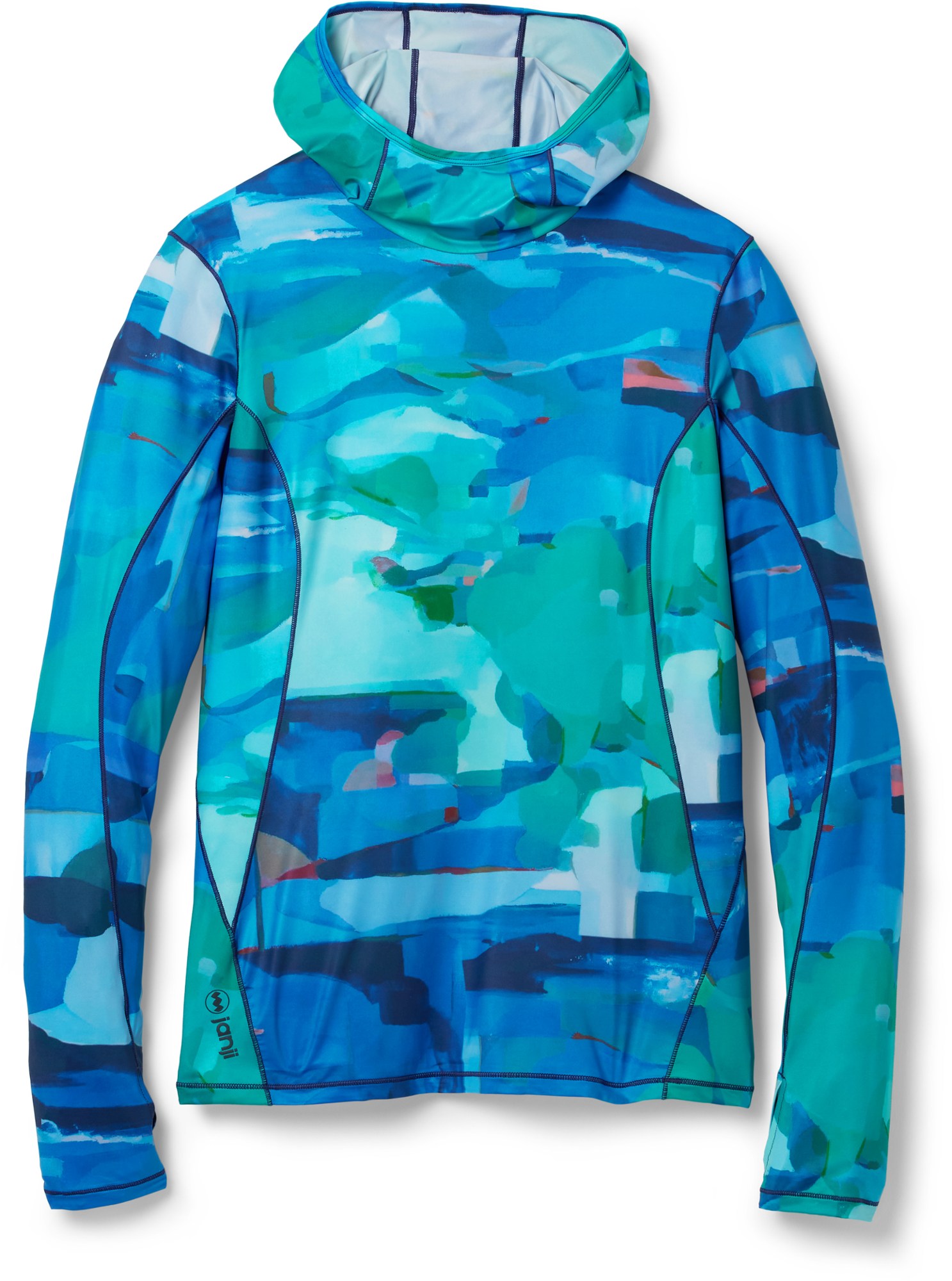
Pros: Incredibly lightweight/breathable, scuba-style hood
Cons: No stash pocket
Hood: Yes
Thumb Loops: Yes
UPF Rating: 50
Materials: 84% recycled polyester, 16% spandex
Janji is a brand that wasn’t on our radar until recently and we’re so glad we discovered it. Janji is focused on running and active endeavors and the Janji Sunchaser 50 fits the bill. We don’t know how their team made this fabric as lightweight, breathable, and comfortable as it is, but they crushed it with the Sunchaser 50. The scuba-style hood comes up snug around the face so it doesn’t bounce around while running or hiking, and the thumbholes keep the sleeves over your hands. The only thing the Sunchaser is missing is a pocket to stash your key.
Of all the sun shirts we tested, the Sunchaser was the lightest and felt cool against the skin. We have a difficult time wearing long sleeves when it’s hot outside but the Sunchaser was so lightweight and breathable that she hardly noticed she was wearing it. Thanks to its comfort, breathability, and fun design, the Sunchaser was our top pick for all the sun shirts we tested.
Check Women's Price on Janji CHECK Women's PRICE ON REI
CHECK Men's PRICE ON REIRunner-Up Best Sun Shirt
Free Fly Lightweight Hoodie II ($68)
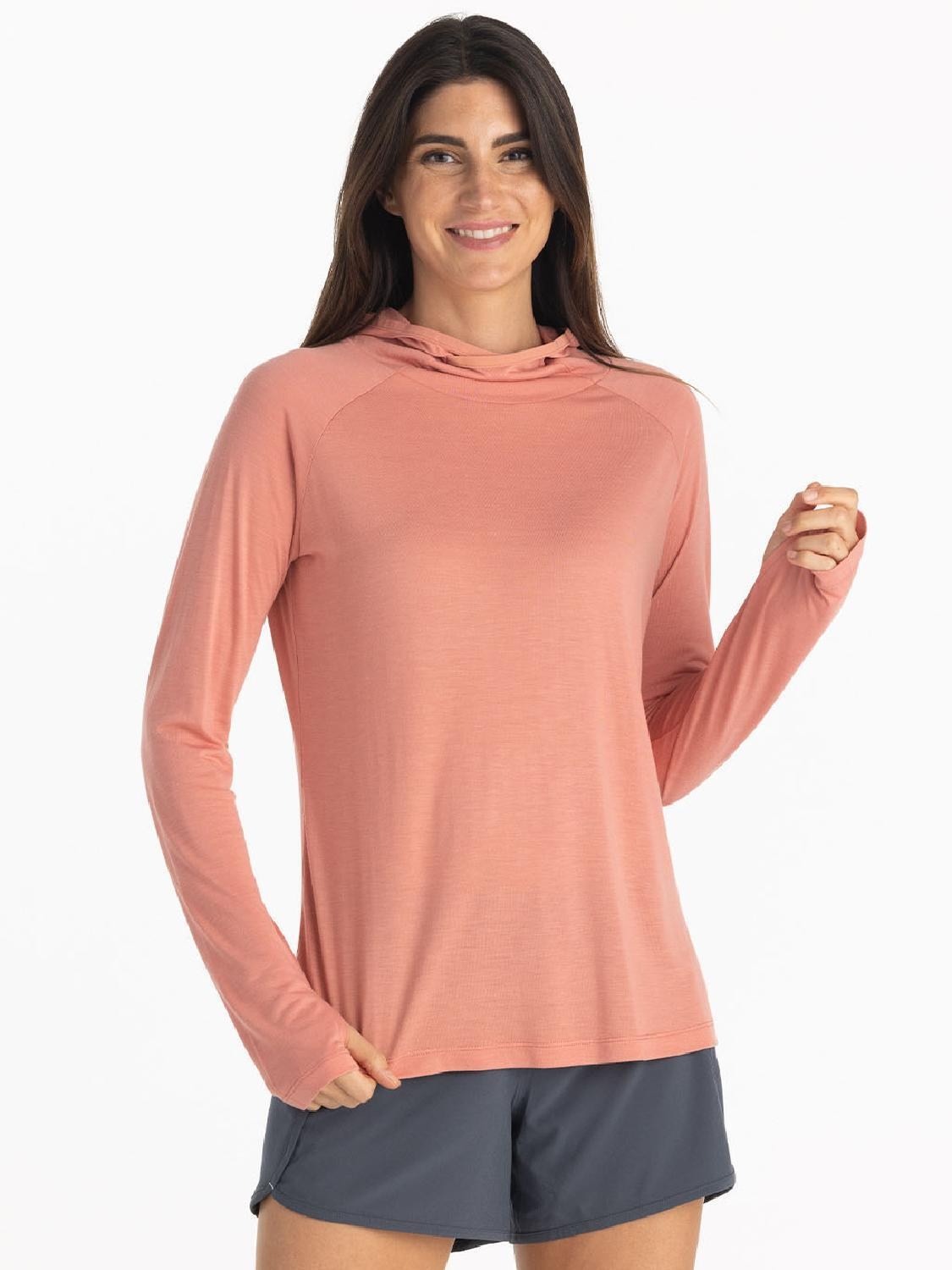
Pros: Made from bamboo, soft material
Cons: Shrinks when you wash it
Hood: Yes
Thumb Loops: Yes
UPF Rating: 20+
Materials: 70% viscose from bamboo, 30% polyester
One of the more unique sun shirts on our list, the Free Fly Lightweight Hoodie II is made from a blend of bamboo and polyester. Bamboo is a great pick for sun shirts as it is incredibly soft, provides generous UV protection, dries quickly, is breathable, and has anti-odor properties. The Hoodie II certainly checks all of those boxes. It’s so soft it could double as a pajama shirt, and the breathable material is perfect for a hot day.
Drawbacks do exist. The shirt requires a delicate wash, and a hang dry, according to Free Fly. We didn’t give it that, and the material “pilled,” or created small clinging lint balls of escaped fibers, after the first wash. Other details hit the mark, though, like the arm pattern that provided mobility in the shoulders and a snug wrist fit — and a hood that fit snugly over a helmet or hat.
The hood sports a high neckline so you’re extra-protected and the thumb holes help keep your hands covered. The Hoodie II has a loose fit, but it does shrink a bit when you wash it, so make sure you have some wiggle room to start with. We didn’t know bamboo was a fabric that we needed in our lives, but the Lightweight Hoodie II has us convinced that we should start looking for more bamboo products.
CHECK Men's PRICE ON REI CHECK Women's PRICE ON REI
Best Fitting Sun Shirt
Cotopaxi Sombra Sun Hoodie ($75)
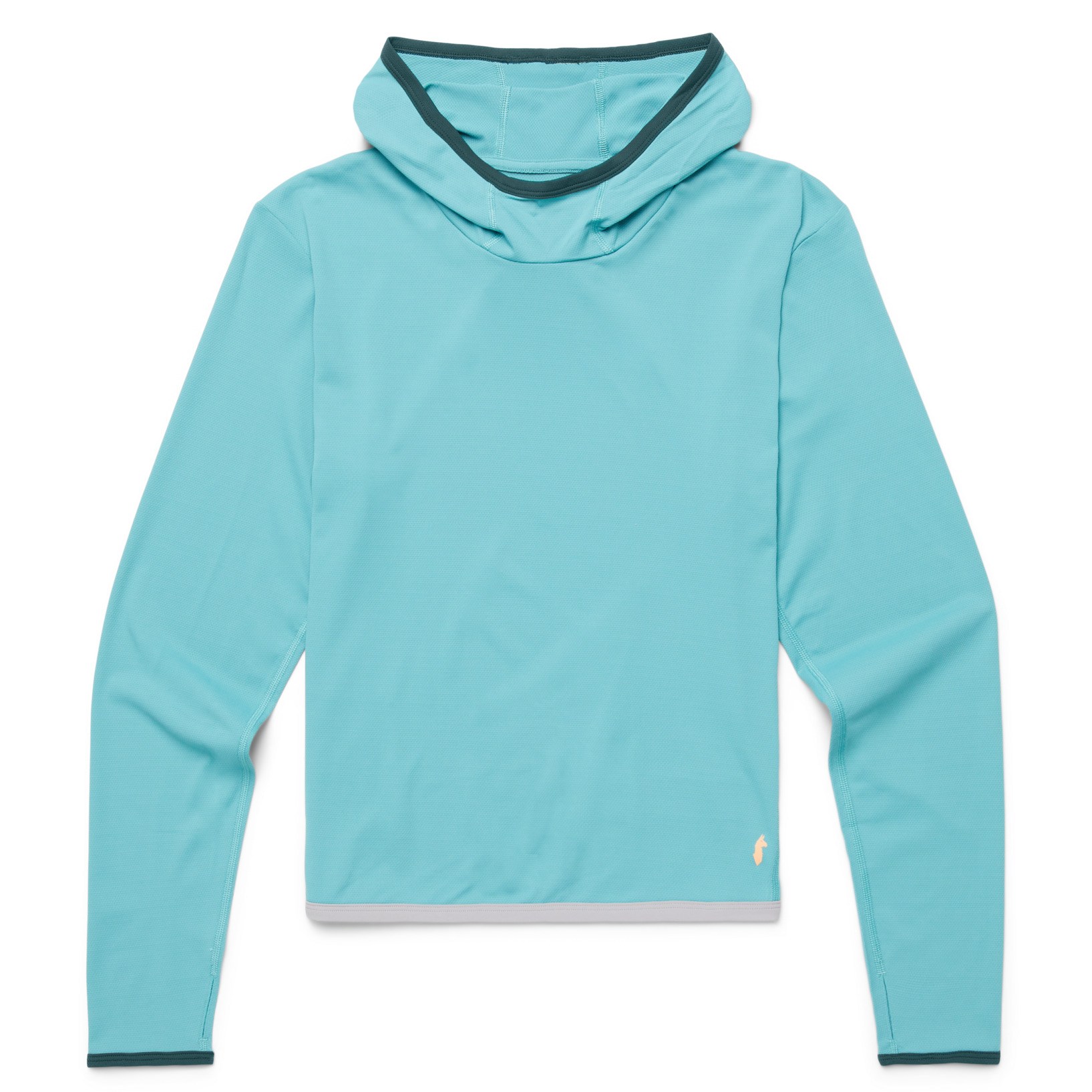
Pros: Incredibly lightweight, breathable, zippered stash pocket
Cons: Runs a little short
Hood: Yes
Thumb Loops: Yes
UPF Rating: 50
Materials: Knit/recycled polyester, 85% nylon/15% spandex
Cotopaxi may not be the first brand that comes to mind when you think of sun shirts, but the Sombra Sun Hoodie is a stellar shirt. Made from a blend of polyester, nylon, and spandex, the Sombra is lightweight and oh-so-breathable. Designed specifically for hiking, the shirt has an antimicrobial finish to keep you smelling fresh. The scuba hood and thumb holes provide generous sun protection and the fit is slightly slimmer at the wrists and hood to ensure they don’t slide around.
Some users complained about the length being a little short, but our 5’7″ female tester found that a women’s medium fit her perfectly. You may want to order a size up if you’re between sizes. We found that the Sombra was great to wear on its own or as a second layer over a tank top. The Sombra finished just behind the Janji Sunchaser because the fabric wasn’t quite as soft nor was the hood as fitted.
CHECK Men's PRICE ON REI CHECK Women's PRICE ON Cotopaxi
Best Dressed Sun Shirt
Kuhl Response Lite Button-Up ($89)
Pros: Temperature control without taking off, dialed construction and details, quick-drying
Cons: Very large in size
Hood: No
Thumb Loops: No
UPF Rating: 30+
Materials: 100% polyester
If you’re wearing a sun shirt, it’s hard not to be obvious about it — unless you’re rocking the Kuhl Response Lite. True to form, Kuhl delivers a low-key casual take on an outdoor garment staple with this button-up, in either short or long sleeves.
How does it perform? We found the shirt promoted fairly profuse sweating but stayed cool, dried quickly, and resisted odor moderately well. We liked the secure snaps and the well-placed roll-up tabs, which kept extra sleeve material out of our way and didn’t let it bunch up around the elbows. The overall effect was to make us reach for it on relaxed days in camp or on the pontoon when it was easy to forget about sunscreen and a couple of buttons up or down could make a big difference in temperature comfort.
Quality abounded, from the consistent stitching to the reinforced 1mm nylon cord hanging loop. The loop inspired confidence when we hung the shirt up soaking wet, which happened often. The sewn-in sunglass chamois was a thoughtful touch, but caused a minor complaint — we found it too small for practical use.
Unlike most sun shirts on this list, the Response Lite fabric cooled us best when it soaked and matted to their skin. Our lead tester observed that this made sense: the shirt could breathe through the front opening or the neck. It made for an old-fashioned sun-protective feel, which we welcomed as a departure from the run-of-the-mill.
We’re only docking points from Kuhl in one department: the sizing. While we found the fit made sense — subtle torso taper, roomy shoulders, and cuff buttons for narrow or robust wrists — the shirt was very generous in size. On our 5’7” lead tester, the hem of a size small reached halfway down his thigh. Size down if you prefer a snug fit.
Check Price on KuhlBest Short-Sleeved Sun Shirt
Rabbit UPF ICE Polo ($60)
Pros: Very smooth fabric texture, passable in a meeting, effective armpit vents
Cons: wrinkles easily, heavy collar
Hood: No
Thumb Loops: No
UPF Rating: 30+
Materials: 68% nylon, 23% ice-cafe nylon, 9% spandex
Because anyone can benefit from finding the right sun shirt, they don’t only belong in the world of anglers or long-distance hikers. That’s the concept that drives the UPF ICE Polo, and Rabbit sticks the landing. We didn’t wear a softer, smoother textile for this article. And though it wasn’t the highest-performing shirt in the roundup, it offered substantial gains over many non-UPF polos.
The first thing that hit us about the ICE Polo was its texture. It felt significantly more silken than any other sun shirt we’d tried on. That’s due in part to Rabbit’s “ice-cafe” nylon, which incorporates spent coffee grounds as a manufacturing additive.
Throughout testing from boat decks to poolside hangouts to golf courses, it held its soft, springy structure. The fabric felt the same after multiple washes and seemed to hold up well under snags and general rough treatment.
It also presented the same characteristics when our lead tester started to sweat through it. Even though the material was far from light, it still sashayed pleasingly across the skin, creating a margin of tolerability on multiple 100℉+, cartless golf games. The laser-cut armpit vents didn’t hurt, either.
The ICE polo loses a few points for a heavy collar and button plate. Rabbit chose double-layered patterns for these components, and the extra thickness makes it clear how heavy the material really is. We also noticed it wrinkled pretty easily, worn against a car seat or stuffed into a backpack.
Still, we preferred it for light-duty summer junkets like quick bike rides or patio mixers. And if you like the look but you’re not sure about the short-sleeved cut — consider a pair of UPF sleeves.
Check Price on RabbitBest Value Sun Shirt
Patagonia Capilene Cool Daily Hoody ($65)
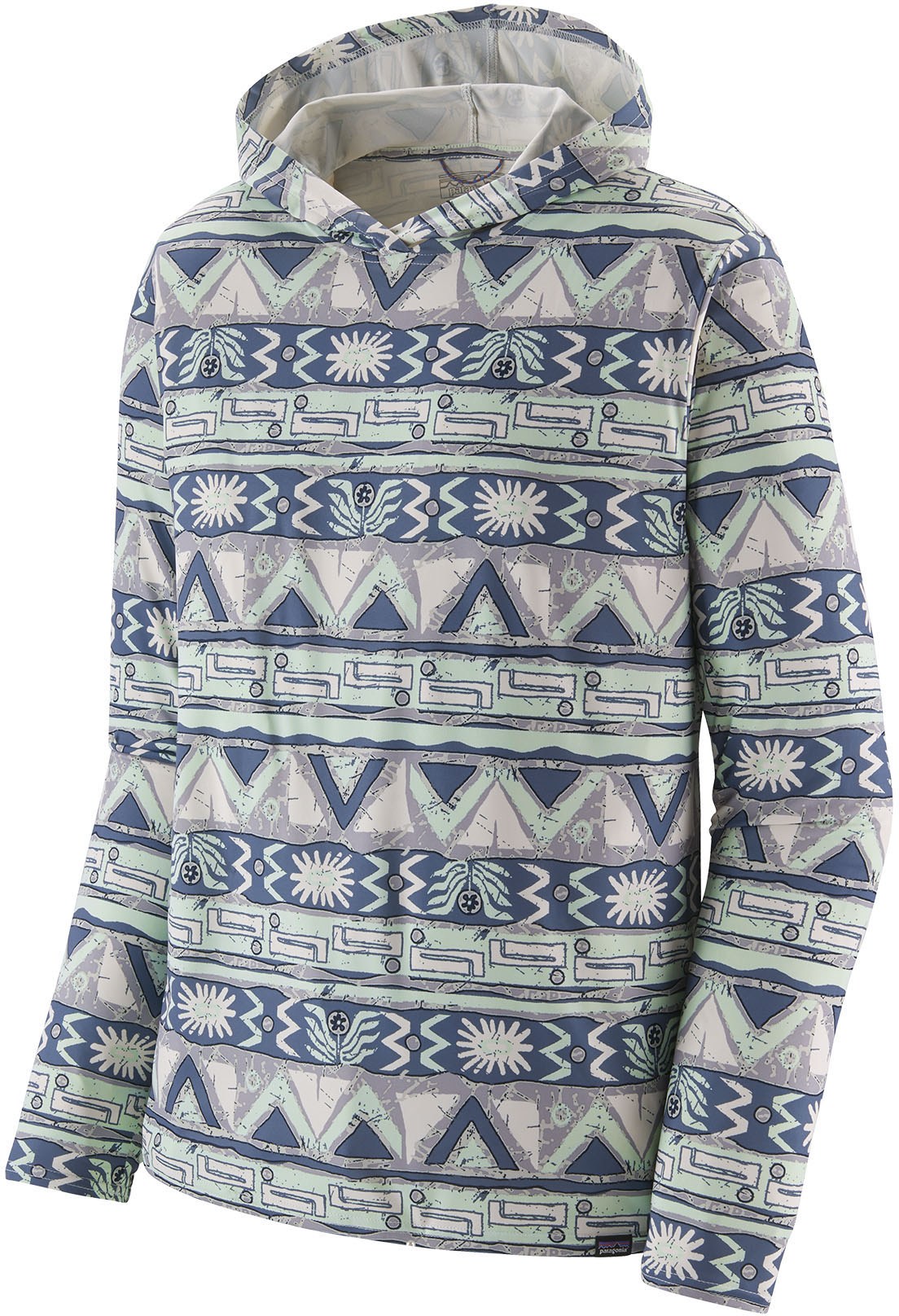
Pros: Made from recycled materials, dries quickly
Cons: No thumb holes, no UPF rating
Hood: Yes
Thumb Loops: No
UPF Rating: N/A
Materials: 3.7 oz recycled polyester jersey (bluesign-approved)
Patagonia hit the nail on the head with their Capilene Cool collection. The Patagonia Capilene Cool Daily Hoody is lightweight and breathable, helping to keep you cool during hot days on the trails. The Daily Hoody does an excellent job of wicking away moisture and it dries out quickly. The Daily Hoody has a hood to keep the sun off your neck but it lacks thumb holes. The built-in odor control works to keep the stink at bay. Fair Trade Certified and made from recycled materials, the Daily Hoody is a shirt you can feel good about wearing. This shirt also comes in a non-hooded version as well.
The Capiline Cool Daily Hoody doesn’t have a UPF rating, simply because Patagonia hasn’t submitted it for the specific test to acquire the rating. The shirt does provide ample sun protection, but because it doesn’t have a specific UPF rating, it’s difficult to know exactly how much protection it provides. That said, we wore this sun shirt while paddling in strong sunshine on the island of Palau, as well as on hikes in Hawaii, and did not get a sunburn.
CHECK Men's PRICE ON Patagonia CHECK Men's PRICE ON REI
CHECK Women's PRICE ON Patagonia CHECK Women's PRICE ON REI
Best Sun Shirt For Cold Weather
The North Face Dune Long-Sleeve Shirt ($60)
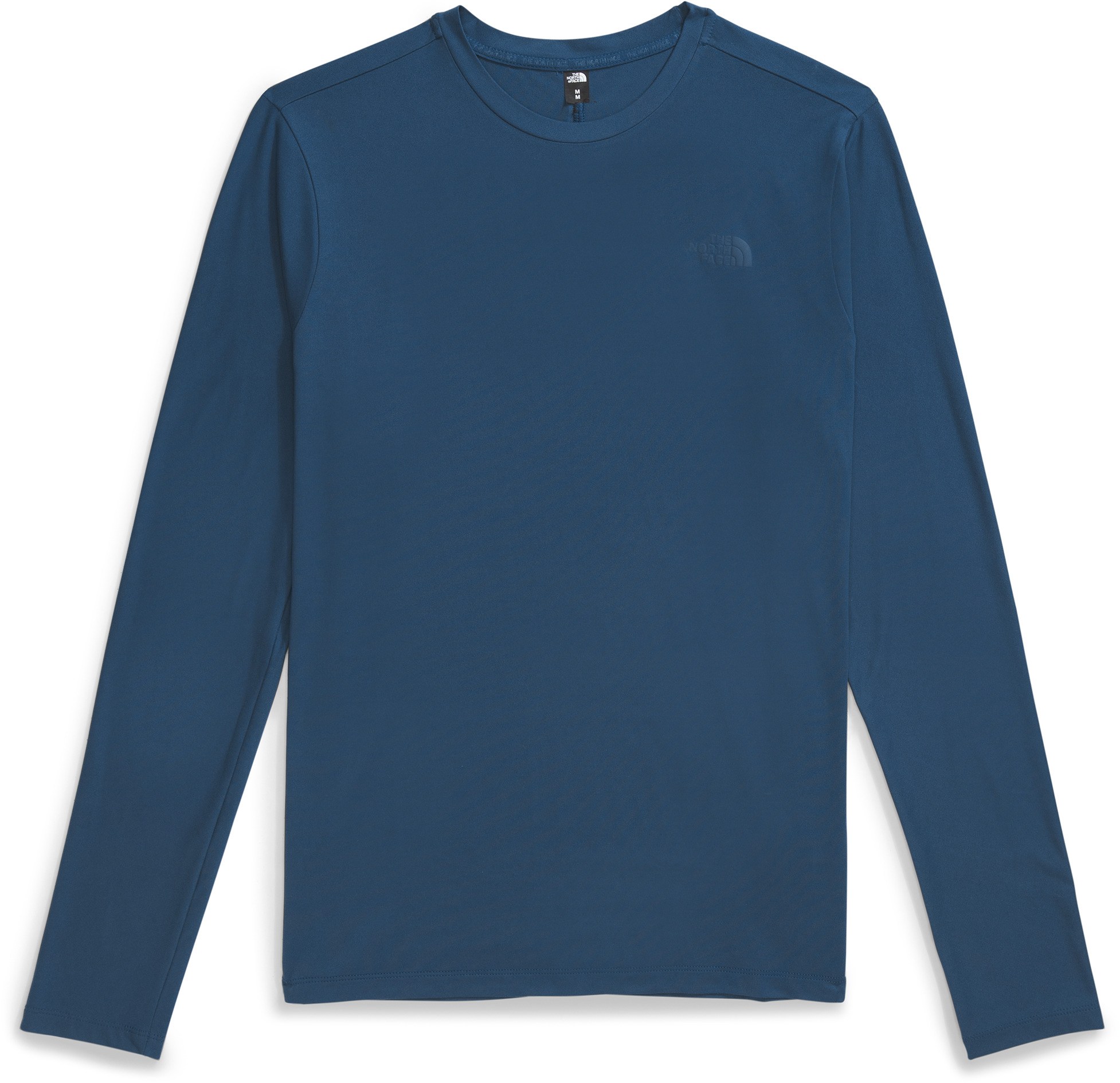
Pros: Made from recycled materials
Cons: Warm
Hood: No
Thumb Loops: No
UPF Rating: 40
Materials: 75-denier x 20-denier 160 g 91% recycled polyester, 9% elastane jersey knit with FlashDry
The North Face Dune Long-Sleeve Shirt is a simple, no-frills sun shirt. The Dune has no hood and no thumb holes, but the shirt is rated UPF 40, so it provides ample sun protection for the chest, arms, back, and shoulders. Although the fabric is lightweight and fairly breathable, we found the Dune was one of the warmer sun shirts on our list and felt it would be best for slightly cooler hikes or as a base layer. However, the Dune does a great job at wicking away moisture and the anti-odor properties keep it smelling fresh.
CHECK PRICE ON REIBest Sun Shirt For Water Sports
Carve Designs Lake Sun Shirt ($68)
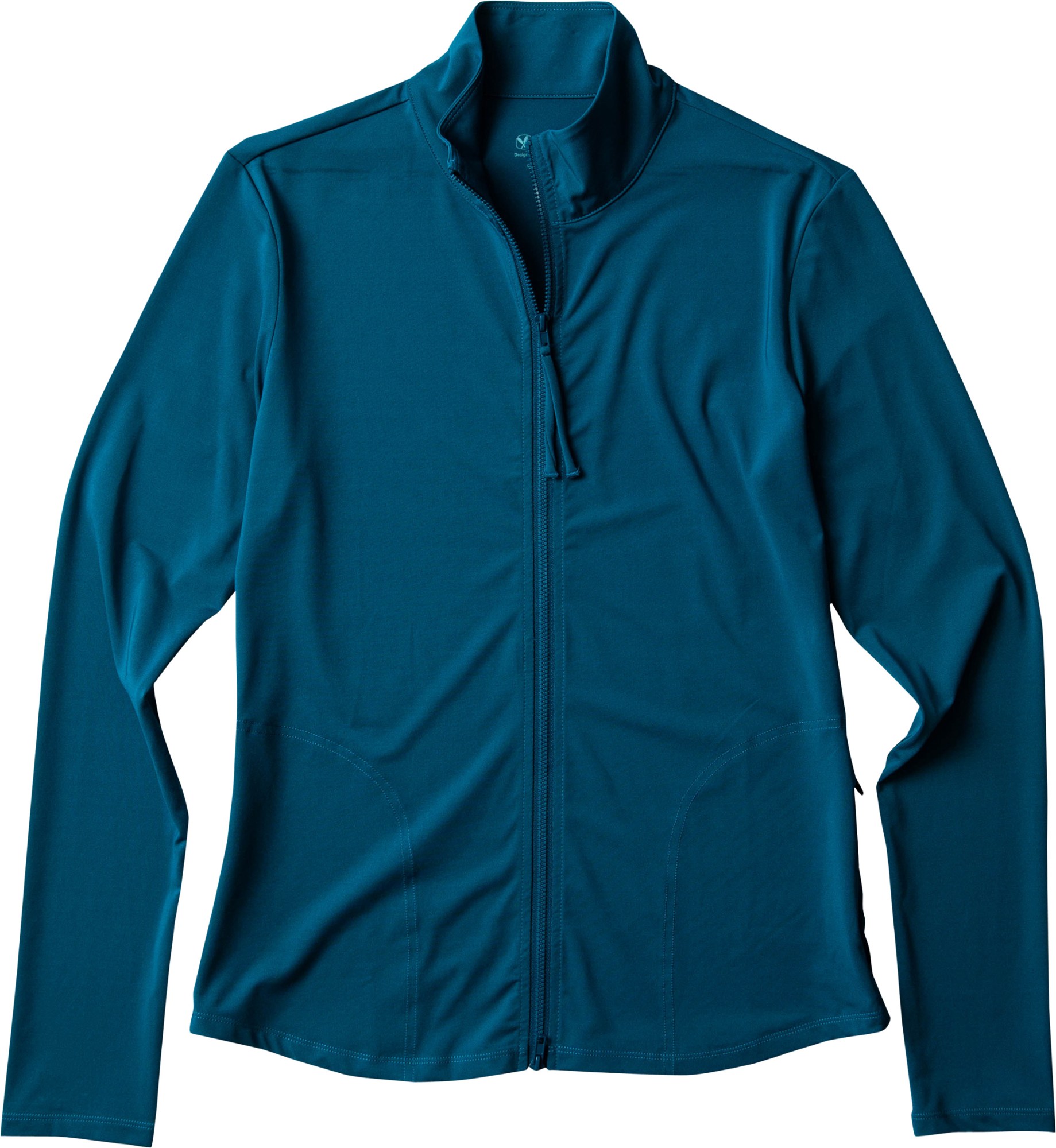
Pros: Full-length zipper, dries quickly
Cons: Thicker material, no hood or thumb holes
Hood: No
Thumb Loops: No
UPF Rating: 50
Materials: 82% recycled polyester, 18% spandex
The Carve Designs Lake Sunshirt feels like a cross between a sun shirt and a rash guard. The material is on the thicker side, like a rash guard, and not as breathable as your typical sun shirt. As such, the Lake Sunshirt might not be your best bet for hikes, but due to its UPF 50 rating and quick-dry properties, it’s a great pick for water sports. The full-length zipper is nice because you can zip it up for maximum sun protection or open it to cool off.
The Lake Sunshirt is semi-fitted but Carve Design’s products tend to run a little big. We’d recommend ordering your usual size for a slightly baggy fit. Unfortunately, this shirt only comes in women’s sizing and styles…sorry boys!
CHECK PRICE ON REIBest of the Rest
Patagonia Tropic Comfort Natural Shirt ($99)
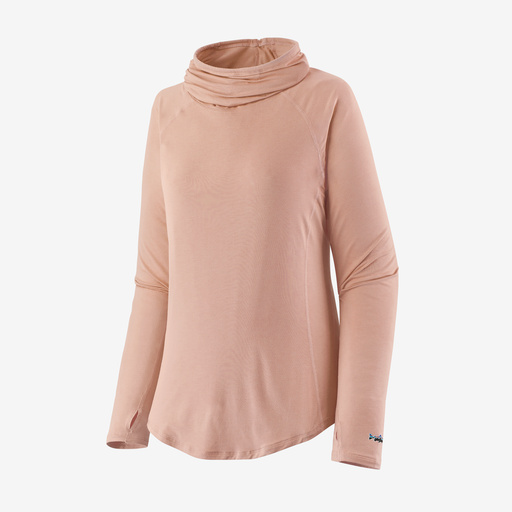
Pros: High neck buff, zippered pocket
Cons: Slightly warm, sleeves too long for some
Hood: Yes
Thumb Loops: Yes
UPF Rating: 40+
Materials: 96% modal sun, 4% spandex jersey
Like most things from Patagonia, the Tropic Comfort Natural Shirt is well thought-out and incredibly durable. Complete with a hood and thumb holes, the Tropic Comfort has a high neck buff that can be adjusted along with the hood for maximum sun protection. The fabric is breathable and dries quickly, but we found it was a bit warmer than some of the other shirts on our list — keep in mind we were hiking in Hawaii while testing.
The sleeves are on the long side for maximum protection. At 5’7″ our female tester thought they fit perfectly, but they may be too long for some. Finally, there’s a small, zippered pocket on the side which we found handy for stashing lip balm and other small essentials.
CHECK Men's PRICE ON Patagonia CHECK Women's PRICE ON PatagoniaNRS H2Core Silkweight Long-Sleeve Shirt ($58)
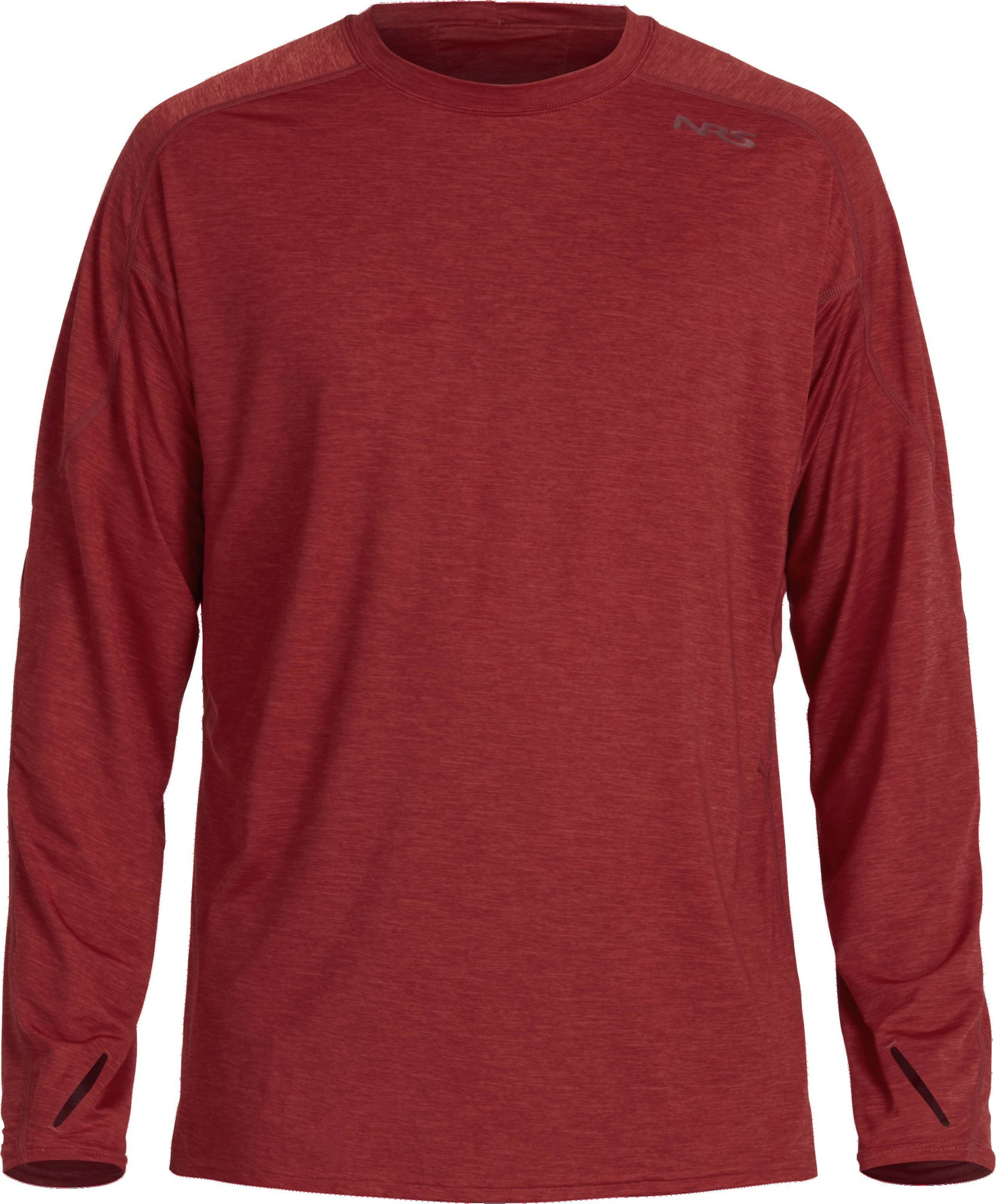
Pros: Dries quickly, strategically-placed seams mean no chafing
Cons: Runs a little big
Weight: 10 oz
Hood: No
Thumb Loops: Yes
UPF Rating: 50
Materials: 85% recycled polyester, 15% recycled spandex
Designed for life on the river, the NRS H2Core Silkweight Long-Sleeve Shirt is a sun shirt that is meant to get wet. Made from a blend of polyester, the H2Core does a great job at wicking sweat and moisture away from the body. It also dries quickly should you go for a swim. The seams are strategically placed, meaning no chafing when you row, paddle, or hike. The shirt features a dropped hem for extra coverage.
At 5’9″, one of our male testers felt that the shirt ran a little big and long. If you prefer a tighter fit, you might want to size down. We wore this shirt for a weeklong sea-kayaking trip and was happy with how well it protected him from the sun, how comfortable it was to paddle in, and how well it dried out each night.
CHECK PRICE ON REI Check Price on Amazon
Fjallraven Abisko Sun Hoodie ($95)
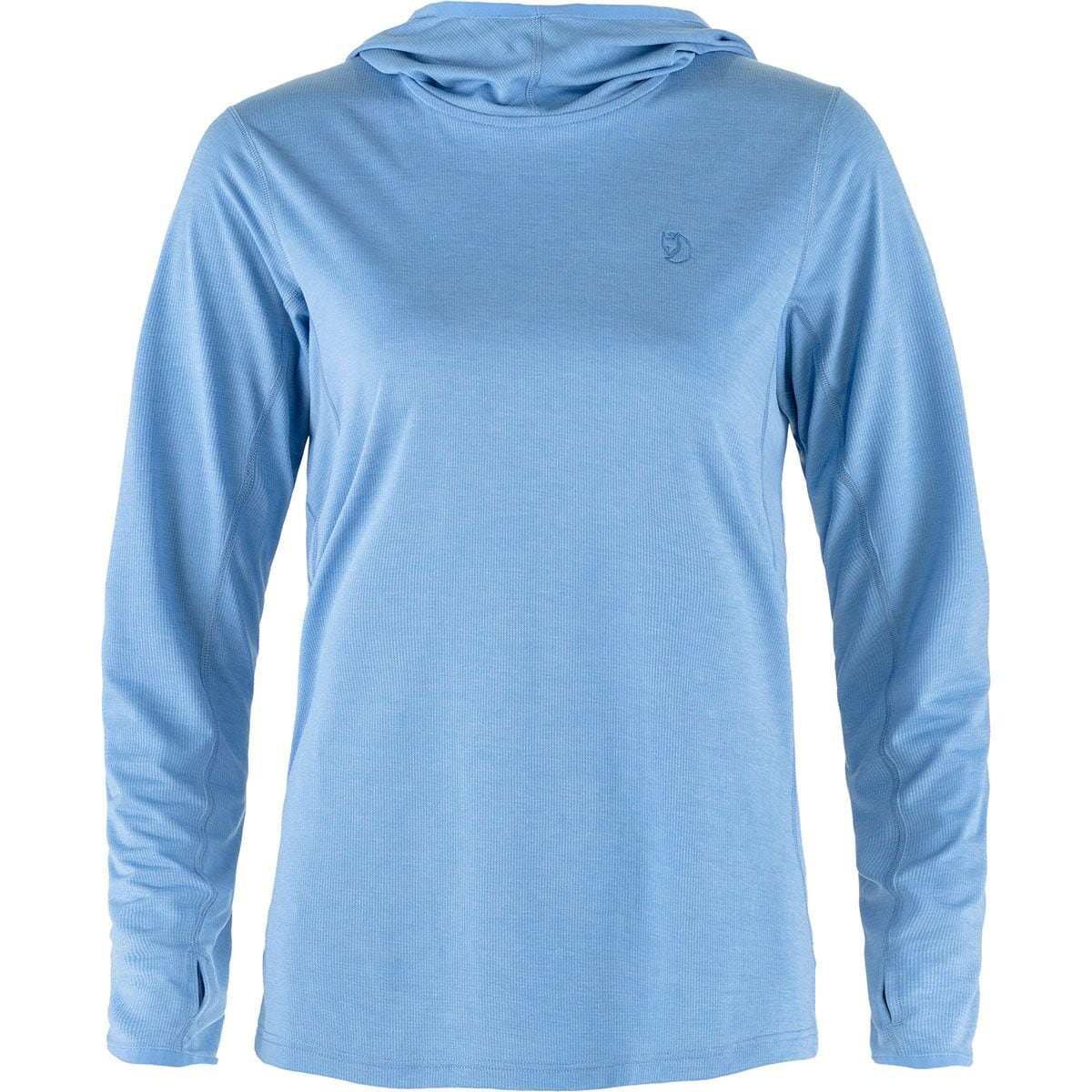
Pros: Elastic along hood and wrists
Cons: Material isn’t very soft
Hood: Yes
Thumb Loops: Yes
UPF Rating: N/A
Materials: Recycled polyester
Made from recycled polyester, the Fjallraven Abisko Sun Hoodie is lightweight and breathable. The Abisko has a hood and thumb holes to keep you covered. On both the hood and the wrists, there’s an elastic band, which was super helpful for keeping both in place.
Although the material is lightweight, it’s not the softest to the touch. The Abisko doesn’t have an official UPF rating, but it kept us plenty protected on sunny hikes in Hawaii. Even though this was a solid sun shirt, we found the other shirts we’ve listed above to be a better combination of price, functionality, and comfort.
CHECK Men's PRICE ON REI CHECK Women's PRICE ON BackcountryMountain Hardwear Crater Lake Hoodie ($70)
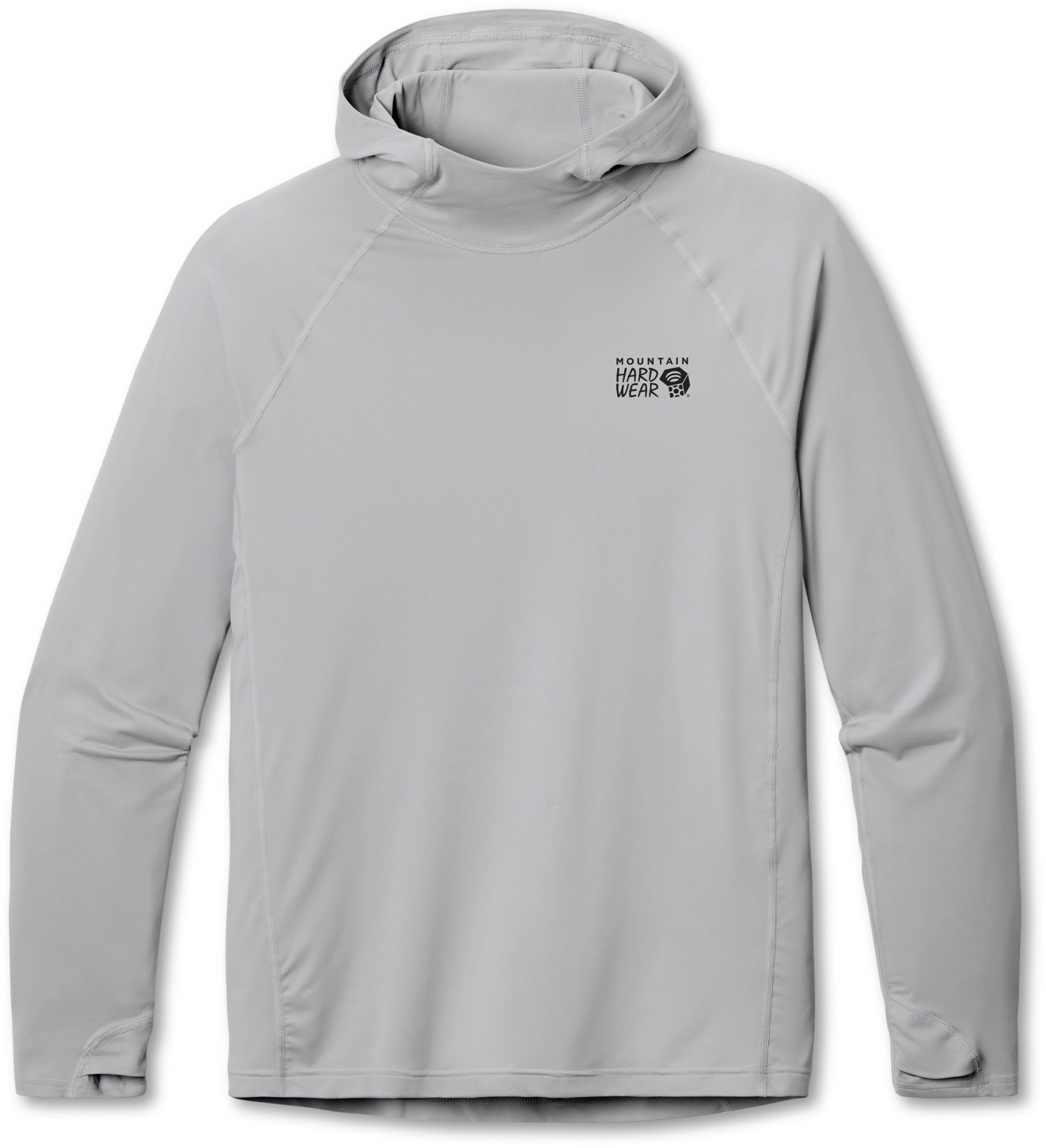
Pros: Buttery-soft fabric
Cons: Runs a bit small
Hood: Yes
Thumb Loops: Yes
UPF Rating: 50+
Materials: 88% polyester, 12% elastane
The Mountain Hardwear Crater Lake Hoodie is incredibly soft and insanely comfortable. The hoodie is lightweight and the fabric feels buttery soft against the skin. The material is stretchy and the hood and thumb holes ensure you stay covered. The shirt also boasts a UPF rating of 50+, among the best on our list. The shirt does a great job of wicking moisture away from the skin and the Crater Lake dries out quickly if you get it wet. This shirt runs a tad small, so if you prefer a looser fit, we suggest sizing up.
CHECK Men's PRICE ON REI CHECK Women's PRICE ON REIBlack Diamond Alpenglow Hoodie ($95)
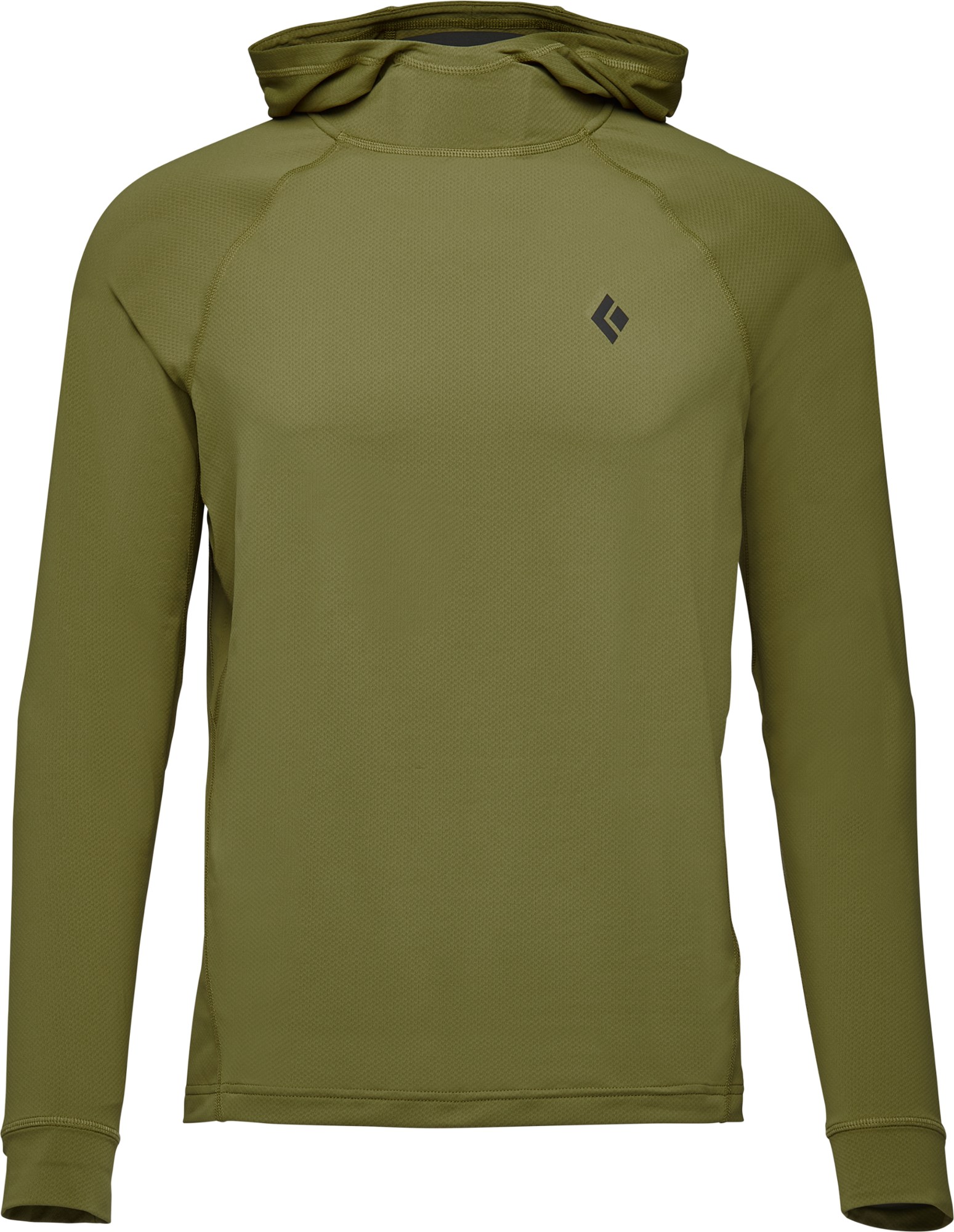
Pros: Cooling fabric
Cons: No thumb holes
Hood: Yes
Thumb Loops: No
UPF Rating: 50
Materials: 87% polyester/13% elastane
The Black Diamond Alpenglow Hoodie was designed for hot, sunshiny days. We wore this shirt on hot and difficult hikes in Hawaii and was impressed at how lightweight and breathable it was. The Alpenglow features an in-fiber cooling technology that works to reflect 71% of near-infrared rays. We can’t speak to that specific statistic, but we did find that the Alpenglow did a great job of keeping us cool. The shirt doesn’t have thumb holes, but it has a stretchier material at the wrists that helps keep the sleeves in place.
CHECK Men's PRICE ON REICHECK Women's PRICE ON REI
Best Sun Shirts Comparison Table
| Sun Shirt | Price | UPF Rating | Hood | Thumb Holes | Materials |
| Janji Sunchaser 50 | $78 | 50 | Yes | Yes | 84% recycled polyester, 16% spandex |
| Cotopaxi Sombra Sun Hoodie | $75 | 50 | Yes | Yes | Knit/recycled polyester, 85% nylon/15% spandex |
| Free Fly Lightweight Hoodie II | $68 | 20+ | Yes | Yes | 70% viscose from bamboo, 30% polyester |
| Kuhl Response Lite | $89 | 30 | No | No | 100% Polyester |
| Rabbit UPF ICE | $60 | 30+ | No | No | 68% nylon, 23% ice-cafe nylon & 9% spandex |
| Patagonia Capilene Cool Daily Hoodie | $65 | N/A | Yes | No | 3.7 oz. recycled polyester jersey (bluesign-approved) |
| The North Face Dune Long-Sleeve Shirt | $60 | 40 | No | No | 75-denier x 20-denier 160 g 91% recycled polyester, 9% elastane jersey knit with FlashDry |
| Carve Designs Lake Sunshirt | $68 | 50 | No | No | 82% recycled polyester, 18% spandex |
| Patagonia Tropic Comfort Natural Shirt | $99 | 40+ | Yes | Yes | 96% modal sun, 4% spandex jersey |
| NRS H2Core Silkweight Long-Sleeve Shirt | $58 | 50 | No | Yes | 85% recycled polyester, 15% recycled spandex |
| Fjallraven Abisko Sun Hoodie | $95 | N/A | Yes | Yes | Recycled polyester |
| Mountain Hardwear Crater Lake Hoodie | $70 | 50+ | Yes | Yes | 88% polyester, 12% elastane |
| Black Diamond Alpenglow Hoodie | $95 | Yes | No | 50 | 87% polyester/13% elastane |

The best sun shirts in the biz. Photo: Rebecca Parsons//The Inertia
How We Tested Sun Shirts
Our lead tester, Rebecca Parsons, lives on Oahu where there is no shortage of sunshine. She spends all of her free time outdoors hiking, standup paddling, surfing, and running. To test these shirts, our team wore them on their daily adventures. They took into consideration how comfortable and breathable the shirts were, their special features, and how well they blocked the sun.
In addition to testing in Hawaii, Parsons and her husband recently took a trip to Palau where they went on a seven-day sea kayaking trip. They brought a few sun shirts with them and truly put them to the test, kayaking every day in the sunshine.
Meanwhile, Sam Anderson patrolled the American southwest on sport climbing trips, road bike rides, and casual rendezvous. If you’re interested in climbing outdoors during Texas and Colorado summers, you’d better want it — just ask Sam.
He sweated it out on sun-drenched 90℉ belay ledges, muggy hikes between dense woods and bone-dry creekbeds, and light-duty hangouts like campground days and boat trips. He tested breathability by comparing comfort in different weather conditions. He got intimate with odor resistance by living beyond laundry range for six days at one famous crag. And he tested the cooling capacity of textiles involuntarily — by being trapped in direct sun on belay.
As a team, we prioritized long-term testing to develop a sense of how materials shrunk or softened, stood up to wear and tear, or broke in. Finally, everywhere except under our shirts, we wore sunscreen. Lots and lots of sunscreen.

We hiked, paddled, and ran in our sun shirts to test them across a wide range of activities. Photo: Julia Borland//The Inertia
Sun Shirts Buyer’s Guide
What Makes a Good Sun Shirt?
UPF Rating/UV Protection
We’ve all heard of a UPF rating, but what exactly does it mean? Ultraviolet Protection Factor, or UPF, measures how much ultraviolet radiation can reach your skin through your clothing. For example, if your shirt has a UPF rating of 30, that means that 1/30th of UV rays can pass through it. Whereas a shirt with a UPF 50 rating will only allow 1/50th of UV rays to come through. Put another way, it reduces your skin’s UV exposure by 50 times. And in concrete terms, the same UPF 50 shirt repels 98% of all UV light.

The higher the UPF rating, the less UV light that can pass through. Photo: Kip Touseull//The Inertia
There are a few factors that will affect a shirt’s UPF rating: construction, fiber type, color, and treatments. Shirts with a tighter weave let less light in and tend to have a higher UPF rating. In general, darker colors are more protective. Some shirts are treated with chemicals and dyes that help absorb UV light. And finally, certain fibers, such as polyester and nylon, are better at blocking UV light.
Just because a shirt doesn’t have a UPF rating listed doesn’t mean that it won’t provide protection from UV rays. If the shirt has been put through the standardized UPF testing procedure then it will have a rating, otherwise it will not.

Breathable fabric is especially important if you’ll be hiking in your sun shirt. Photo: Rebecca Parsons//The Inertia
There are also multiple differences between UPF ratings and SPF ratings. Sun Protective Factor (SPF) ratings, generally applied only to sunscreen, measure the time the product can delay a sunburn in multiples. SPF 30 will protect your skin 30 times longer than it would take to burn without it — for example, if you would burn in ten minutes with no sunscreen, SPF 30 should keep you safe for 300 minutes.
Finally, SPF products repel only UVB radiation, but UPF fabrics repel both UVA and UVB. The basic difference? UVA rays can penetrate your skin more deeply, reaching the dermis. UVB can only reach as deep as the epidermis (which doesn’t get thicker than two credit cards stacked together).

Breathable, comfortable sun shirts make outdoor pursuits more enjoyable. Photo: Sam Anderson//The Inertia
Breathability
In the outdoor garment industry, it’s a toss-up between which descriptor is more prevalent: “durable water-repellent” or “breathable.” Here in the sun shirt world, we’re clearly more concerned with breathability.
Everyone knows breathability as soon as they feel it. But its mechanics are more complex. Simply put, breathability measures a textile’s ability to allow moisture and air to pass through it. In practice, that means how much of your sweat and body heat can escape through the fabric.
Of course, air can also get in from outside. The common-sense rule is that looser weaves of lighter-weight materials will promote better breathability. Manufacturers also use various, non-standardized systems to rate their products for it.
Actually, Mother Nature makes the rules no matter what. You won’t notice any breathability in a shirt unless there’s a difference in humidity on either side of it. As long-distance hiker Andrew Skurka explains, water vapor naturally moves toward low pressure — so if the humidity inside your sun shirt is 90% and the humidity outside is only 50%, then your sweat will want to move through the shirt and get outside.
However, if it’s also 90% humidity outside? You won’t notice any transfer at all, even though it can still occur.

Hiking in Hawaii is hot. We were grateful to have a breathable sun shirt. Photo: Rebecca Parsons//The Inertia
Hoods
There are pros and cons to a hood. A lot of sun shirts come with one because they allow you to duck for cover on especially punishing days. Most shirts also accommodate a helmet, so you can secure your melon safe and shield your neck all at once. If your goal is maximum sun protection, then you’ll want a hood.
Through our testing, we discovered that not all hoods are created equally. Some hoods are loose fitting whereas others are fitted. If you plan on using your sun shirt for active endeavors such as running or hiking, then you’ll want a snug-fitting hood. We found that loose-fitting hoods slide off easily and we had to constantly pull them back up. We also found that loose hoods were more comfortable, so if you only plan on using the hood occasionally, then you may want a loose one.

Hoods help keep the head, ears, and neck protected. Photo: Jaxon Sheley//The Inertia
The downside of hoods is that they make the shirt bulkier and more cumbersome. They can also flop around while running if you’re not wearing it. If you’re not worried about protecting your ears and neck, then a hoodless sun shirt may be your best bet.
Thumb Loops
When it comes to sun protection, you may not think much about your hands and fingers. However, the hands receive a lot of sunshine as they are fully exposed in most types of clothing. To help keep your hands protected, many sun shirts have thumb loops.

Thumb loops ensure your entire hand stays protected: Photo: Rebecca Parsons//The Inertia
Thumb loops are at the end of the sleeve and are small holes just large enough for your thumbs to fit through. This helps ensure the shirt stays extended over your hand. If you prefer to go without the thumb loops, you can simply slide your thumbs out and wear it like a normal shirt. But in our opinion, thumb loops are always a nice option to have.
Material
Polyester remains a standby in most outdoor clothing, but that doesn’t mean it’s always the best consumer option. It’s a petroleum-derived product, and like anything plastic, it doesn’t breathe at all in its raw form. Knit or woven polyester shirts (like many of the entries in this article) can promote breathing, but the weave pattern has to overcome the shirt’s fibers to do it.
However, it also scores lots of UPF points. Wool rates comparably to poly fabrics, but natural fibers like cottons and linens fall far behind.
Of course, those aren’t the only options. Our favorite sun shirt fabrics in this article incorporate polyester along with more innovative materials that promote comfort, moisture transfer, and other desirable qualities.
We preferred the astonishing odor resistance and soft quality of Free Fly’s 70% viscose bamboo and Rabbit’s silky, pliable nylon manufactured with spent coffee grounds.
Wait, what?
Yes, 28% of Rabbit’s UPF ICE Polo is “ice-cafe” nylon. While we’re currently awaiting specifics from the brand, it’s possible to render spent coffee grounds into yarn, and then spin that yarn into fabric. It still requires some synthetics, but the process is fascinating.

Bamboo fibers, like what’s found in this sun shirt from Free Fly, are soft, odor-managing, and breathable. Photo: Sam Anderson//The Inertia
Finally, anyone who doesn’t need a sun shirt to be an impenetrable UPF fortress could benefit from looking into bamboo. It’s cheap, it’s soft, and it generally fights odors due to antibacterial qualities that can derive from various origins. The plant itself naturally repels bacteria (which, in part, helps it grow like crazy), but the viscose manufacturing process may also help. Note that viscose methods do incorporate chemicals, so your shirt won’t be natural and unspoiled — except for by B.O.
Polyester is the most popular material used for sun shirts. It offers good sun protection, is breathable, and dries quickly. Many of the brands we tested incorporated some spandex or elastane into the shirts as well to give them some stretch.

After a day of fun, we want our sun shirts to be dry and comfortable back at camp. Photo: Sam Anderson//The Inertia
Quick-Drying
Does getting your clothes wet kill your UPF rating? Actually, according to one of the few studies that aimed to find out, viscose and untreated polyester fabrics repel more UV rays when they’re wet than when they’re dry. Results varied for any other fabric, including polyester coated with titanium dioxide (TiO2), a common UPF treatment.
In general, though, nobody wants to walk around wearing wet clothes. Natural fibers tend to dry more slowly than synthetics because synthetics don’t absorb water.
In testing, we noticed some shirts performed pretty well when wet. The Kuhl Response Lite saturated relatively easily and didn’t cling to us, but instead tended to become a cool, sliding sheet on the skin underneath. The button-up construction made it easy to shed, and it dried quickly in any light wind.

Fit and features are crucial for a sun shirt to make our regular rotation. Photo: Sam Anderson//The Inertia
Fit
While fit ultimately comes down to personal preference, a general rule of thumb is that you want your sun shirt to fit slightly baggy. Having a looser fit, allows your shirt to breathe better and encourages free range of motion. Erring on the larger size will also help ensure that your shirt’s thumb loops (if it has them) and sleeves fully cover and protect your hands. If you’re between sizes, we generally recommend sizing up.
Size standards do vary across manufacturers. The truest-fitting shirt in our opinion, the Cotopaxi Sombra, seemed smaller than most. Kuhl was very roomy (our tester would have gone a size down) and Free Fly was roughly accurate.
Return to Comparison Table | Return to Top Picks
Editor’s Note: Getting out in the sun? You’ll need more than just a sun shirt. Check out our Gear Guides for the Best Reef-Safe Sunscreens, Best Sun Hats, and Best Sunglasses. For more gear reviews and features on The Inertia, click here.




